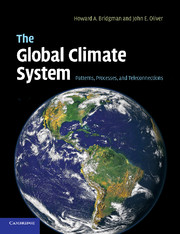Book contents
- Frontmatter
- Contents
- List of contributors
- Preface
- List of abbreviations
- 1 Introduction
- 2 Oscillations and teleconnections
- 3 Tropical climates
- 4 Middle-latitude climates
- 5 Climate of the polar realms
- 6 Post-glacial climatic change and variability
- 7 Urban impacts on climate
- 8 Human response to climate change
- 9 ESSAY: Model interpretation of climate signals: an application to Asian monsoon climate (Lau)
- 10 Conclusions and the future of climate research
- Other books on climatology and the climate system
- Index
- Plate section
- References
8 - Human response to climate change
Published online by Cambridge University Press: 05 June 2012
- Frontmatter
- Contents
- List of contributors
- Preface
- List of abbreviations
- 1 Introduction
- 2 Oscillations and teleconnections
- 3 Tropical climates
- 4 Middle-latitude climates
- 5 Climate of the polar realms
- 6 Post-glacial climatic change and variability
- 7 Urban impacts on climate
- 8 Human response to climate change
- 9 ESSAY: Model interpretation of climate signals: an application to Asian monsoon climate (Lau)
- 10 Conclusions and the future of climate research
- Other books on climatology and the climate system
- Index
- Plate section
- References
Summary
Introduction
How human beings and societal organizations respond to climate change is an area of considerable debate. McGovern (1991) points out that unambiguous cases of climate impact are rare, and therefore simple correlations between climate change and human activities are not valid. Climate change and variability are included in a range of impacts that can influence human activities, the way humans live, and how lifestyle decisions are made. Other aspects include the level of technological advancement, societal structure, level of economic development, the influence of warfare, the importance of religion, and so forth. Detection of the role of climate variations and stresses in cultural reactions can be very difficult if some of these other factors dominate the lifestyle and decision-making process. It is, however, essential to consider climate along with these other impacts influencing society, if a complete understanding of cultural reaction is to emerge.
It is impossible in one chapter of a book to explore all the potential relationships between climate and human activity. We therefore focus on the period since about AD 500 (therefore all dates referred to are AD) when human activities were starting to dominate natural processes in parts of the world. At the beginning of this period, agriculture began to define cultural landscapes, creating a more sedentary lifestyle, and enhancing an increase in population. Humans also began to have a bigger impact on the local environment, through activities such as forest clearing, draining and filling wetlands, irrigation, and the creation of dams.
- Type
- Chapter
- Information
- The Global Climate SystemPatterns, Processes, and Teleconnections, pp. 244 - 280Publisher: Cambridge University PressPrint publication year: 2006



